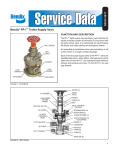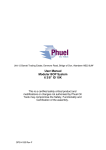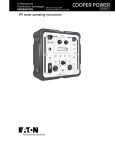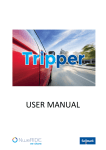Download BENDIX BW1437 User's Manual
Transcript
SD-03-3613 ® Bendix® PP-3™ Trailer Supply Valve DESCRIPTION BUTTON MOUNTING NUT SUPPLY PORT The PP-3™ trailer supply valve, installed in the cab, operates in conjunction with a TP-3™ tractor protection valve to supply air under pressure to the trailer and protect the tractor air supply in case of a break-away or an air leak on the trailer which would reduce the pressure in the trailer supply line below the design trip point of the PP-3™ valve. With reference to Figure 2 the supply port of the PP-3™ valve is supplied from the towing vehicle reservoir. Its delivery goes directly to the supply port on the TP-3™ tractor protection valve. OPERATION DELIVERY PORT FIGURE 1 - PP-3™ TRAILER SUPPLY VALVE EXTERIOR PP-3™ CONTROL VALVE TC-2™ VALVE The PP-3™ control valve is a push-pull operated valve. The button must be pushed in to open the valve. The button will not stay in unless there is 50 psi or more in the supply line. Once the pressure is enough that the button will remain in, air flows through the tractor protection valve to the trailer. DOUBLE CHECK VALVE TP-3™ TRACTOR PROTECTION VALVE TRAILER EMERGENCY LINE TRAILER SERVICE LINE BRAKE VALVE COMPRESSOR NO. 1 RESERVOIR NO. 2 RESERVOIR FIGURE 2 1 that no air escapes at the open trailer service hose coupling. If, in the case of an emergency or for some other reason the driver wishes an application of the trailer brakes, he pulls the PP-3™ valve control button out. Emergency line pressure will exhaust out the PP-3™ valve exhaust port causing an application of the trailer brakes. Also, the TP-3™ inlet valve seats and closes the service line. The PP-3™ valve button is pulled out and left out during bob-tailed operation of the tractor. In normal use the button is pulled out before uncoupling from the trailer and pushed in after coupling to the trailer. 5. When system pressure reaches approximately 60 psi, the PP-3™ valve button should be pushed in. System pressure should show at once on the test gauge connected in the emergency line and the button of the PP-3™ valve should remain in without being held. Should a condition occur resulting in air loss from the tractor or trailer system through leakage and the driver fails to manually pull out the PP-3™ valve button, the PP-3™ valve will automatically close at approximately 40 psi and seal the tractor air lines. The driver cannot, in this condition, overcome the emergency application of the trailer brakes by holding the PP-3™ valve button in. If the driver should hold the button in as emergency line pressure bleeds down from the 40 psi range to approximately 30 psi, the tripper piston will move and open the tripper exhaust in the PP-3™ valve. Emergency line air will exhaust through the tripper exhaust and hold the trailer brakes applied. 7. With PP-3™ valve button still in, check for leakage at PP-3™ valve exhaust and tripper exhaust ports. Leakage should not exceed a 1" bubble in 5 seconds at either point. PREVENTIVE MAINTENANCE Important: Review the Bendix Warranty Policy before performing any intrusive maintenance procedures. A warranty may be voided if intrusive maintenance is performed during the warranty period. No two vehicles operate under identical conditions, as a result, maintenance intervals may vary. Experience is a valuable guide in determining the best maintenance interval for air brake system components. At a minimum, the PP-3™ valve should be inspected every 12 months or 3600 operating hours, whichever comes first, for proper operation. Should the PP-3™ valve not meet the elements of the operational tests noted in this document, further investigation and service of the valve may be required. OPERATING AND LEAKAGE CHECKS To make the following operating and leakage checks, an accurate test gauge installed in a spare hose coupling is required. The vehicle dash gauge should be checked for accuracy against the test gauge prior to making these tests. 1. Block and/or hold the vehicle by a means other than air brakes during these tests. 2. Drain vehicle reservoir supply, then close drain cocks. 3. Connect assembled hose coupling and test gauge in tractor emergency hose coupling. Start engine and build up system pressure. 4. As reservoir pressure builds up there should be no pressure reading on test gauge. When system pressure reaches the 30 to 40 psi range on dash gauge make and hold a foot or hand valve application and observe 2 6. Build system pressure up to approximately 100 psi, then stop engine. With engine stopped, wait momentarily, then notice that dash gauge and test gauge pressure reading equal. While still in this position, make a foot or hand valve application and observe that air is delivered out the open trailer service coupling. 8. With PP-3™ valve button still in, check for leakage at the TP-3™ valve exhaust and open service coupling. Leakage should not be more than a 1" bubble in 5 seconds at either point. 9. Pull the PP-3™ valve button out: pressure on the test gauge connected in the emergency line should drop to zero. Make and hold a hand valve application and observe that air delivered at the open service coupling does not exceed a 1" bubble in 5 seconds. Release foot or hand valve application. NOTE: If the PP-3™ valve does not function as described or if leakage is excessive, it is recommended that it be returned to the nearest Bendix authorized distributor for a factory rebuilt valve. If this is not possible, the valve should be repaired using genuine Bendix parts, in which case the following should prove helpful. REMOVING AND INSTALLING REMOVING 1. Block and/or hold the vehicle by a means other than air brakes. Drain air brake system. 2. Disconnect supply and delivery lines from PP-3™ valve. 3. Drive out PP-3™ valve button roll pin and remove button. Remove PP-3™ valve mounting nut, then PP-3™ valve. INSTALLING When installing the PP-3™ valve, refer to Figure 2 for proper connections along with following explanations: 1. Supply line from tractor reservoir is connected to supply port of PP-3™ valve. 2. Delivery line from PP-3™ valve delivery port is connected to tractor emergency port of TP-3™ valve. 3. PP-3™ valve exhaust port and tripper exhaust must be open. 4. Two (2) ports marked “Del” on upper PP-3™ control valve body are plugged and must remain plugged. DISASSEMBLY PP-3 PUSH-PULL VALVE Inspect seats in upper and lower body for nicks and burrs. Redress seats if damaged. 1. Button pin (1) Figure 3, button (2) and mounting nut (3) are normally removed when valve is removed from vehicle. Inspect plunger and tripper piston bores in bodies and cover for deep scratches or nicks. They should be smooth and clean. 2. Remove two lower body cap screws (4) and lock washers, then lower body (5) with cover (6). Check springs for distortion, corrosion, and cracks. 3. Remove cover with tripper piston (7) from lower body. Replace all parts not considered serviceable during these inspections, especially o-rings and valves. ™ 4. Remove tripper piston and spring (8) from cover. 5. Remove tripper piston and cover seal o-rings (9 & 10). ASSEMBLY 6. Insert rod or punch in upper plunger pin hole and hold plunger (11) from turning while inlet and exhaust valve nut is removed. Prior to assembly, lubricate o-rings and bearing surfaces with silicone lubricant Bendix Pc. No. 291126. 7. Remove washer (13) and valve (14). 2. Position plunger spring (15) in upper body, then press plunger (11) down inside spring in the body. 8. Pull plunger from upper body. 9. Remove plunger spring (15) and o-ring (16). 10. Remove upper body seal ring (17). Do not remove plugs from ports marked “Del” in upper body. CLEANING AND INSPECTION OF PARTS Wash all metal parts in mineral spirits and then dry. 1. Install plunger o-ring (16). 3. Place inlet and exhaust valve (14), then washer (13), over threaded, protruding end of plunger. 4. Install and tighten self-locking nut (12). Torque on the nut should be 30 to 40 inch pounds. 5. Place upper and lower body seal o-ring (17) in place. 6. Install tripper piston o-ring (9). In particular, make sure supply port in PP-3™ valve upper body, tripper by-pass slot, and tripper exhaust port in cover are thoroughly cleaned and unrestricted. 7. Position cover o-ring seal (10) on cover. Inspect all parts for excessive wear or deterioration. 9. Place cover with tripper installed into lower body. BUTTON (2) SPRING (15) SPIROL PIN (1) 10. Fasten lower body and cover assembly to upper assembly with cap screws (4) and lockwashers. Tighten cap screws evenly and securely. PLUNGER (11) TESTING REBUILT PP-3™ VALVE NUT (3) O-RING (16) PIPE PLUG SUPPLY PORT SEAL (17) INLET AND EXHAUST VALVE (14) INLET AND EXHAUST VALVE NUT (12) WASHER (13) EXHAUST PORT DELIVERY PORT LOWER BODY (5) TRIPPER PISTON (7) O-RING (9) O-RING (10) COVER (6) TRIPPER EXHAUST 8. Position tripper spring (8) in cover (6) then press tripper piston (7) down over spring and into the cover bore. TRIPPER SPRING (8) CAP SCREW (4) Perform operating and leakage checks as outlined in previous section. WARNING! PLEASE READ AND FOLLOW THESE INSTRUCTIONS TO AVOID PERSONAL INJURY OR DEATH: When working on or around a vehicle, the following general precautions should be observed at all times. 1. Park the vehicle on a level surface, apply the parking brakes, and always block the wheels. Always wear safety glasses. 2. Stop the engine and remove ignition key when working under or around the vehicle. When working in the engine compartment, the engine should be shut off and the ignition key should be removed. Where circumstances require that the engine be in operation, EXTREME CAUTION should be used to prevent personal injury resulting from contact with moving, rotating, leaking, heated or electrically charged components. FIGURE 3 - PP-3™ CONTROL VALVE 3 3. Do not attempt to install, remove, disassemble or assemble a component until you have read and thoroughly understand the recommended procedures. Use only the proper tools and observe all precautions pertaining to use of those tools. 4. If the work is being performed on the vehicle’s air brake system, or any auxiliary pressurized air systems, make certain to drain the air pressure from all reservoirs before beginning ANY work on the vehicle. If the vehicle is equipped with an AD-IS™ air dryer system or a dryer reservoir module, be sure to drain the purge reservoir. 5. Following the vehicle manufacturer’s recommended procedures, deactivate the electrical system in a manner that safely removes all electrical power from the vehicle. 6. Never exceed manufacturer’s recommended pressures. 4 7. Never connect or disconnect a hose or line containing pressure; it may whip. Never remove a component or plug unless you are certain all system pressure has been depleted. 8. Use only genuine Bendix ® replacement parts, components and kits. Replacement hardware, tubing, hose, fittings, etc. must be of equivalent size, type and strength as original equipment and be designed specifically for such applications and systems. 9. Components with stripped threads or damaged parts should be replaced rather than repaired. Do not attempt repairs requiring machining or welding unless specifically stated and approved by the vehicle and component manufacturer. 10. Prior to returning the vehicle to service, make certain all components and systems are restored to their proper operating condition. BW1437 © 2004 Bendix Commercial Vehicle Systems LLC. All rights reserved. 3/2004 Printed in U.S.A.













